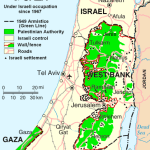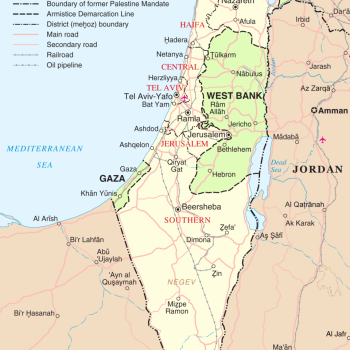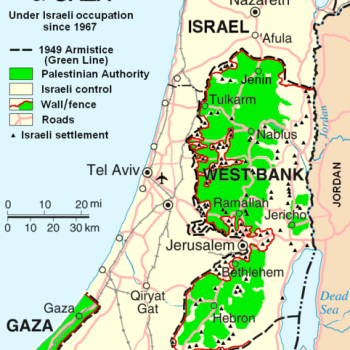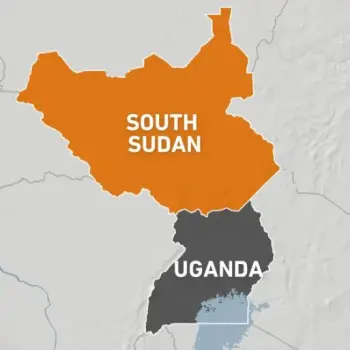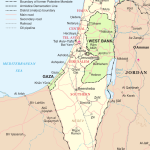
I keep saying this over and over again in blog posts. Moreover, I argued this in my book Palestine Is Coming: The Revival of Ancient Philistia, published 35 years ago. At amazon.com, this book’s description begins, “IS THE TWO-STATE SOLUTION DEAD? “NO,” SAYS ZARLEY, “IT’S THE WRONG ONE.”
The Traditional Two-State Solution
The traditional two-state solution was long ago proposed by Palestinians and largely accepted by the international community. What is it? It is that a Palestinian state be located in two separated territories: the larger West Bank, which Jews call “Judea and Samaria,” and the small enclave the Gaza Strip that lies beside the Mediterranean Sea. These two parcels are separated by about twenty miles. Thus, if this arrangement ever happened, all agree that it would be absolutely necessary for there to be a corridor joining to two Palestinian parcels. But the great weakness of this arrangement has to do with security. That is, in time of war, Israel could easily cut off the corridor. That would place the Palestinian state in great danger. So, a state of Palestine existing in these two separated territories would be a very insecure arrangement for Palestinians.
An online article in The Atlantic today entitled, “Western Nations Are Taking a Key Step Toward a Two-State Solution,” its author Hussein Ibish claims the “West Bank” is “the only territory that could become a true state for Palestinians.” I argue strenuously against this. Moreover, I will now predict, “It ain’t gonna happen!” The article is in lieu of a UN General Assembly meeting next month.
“You Cannot Change History and Religion”
Why have Palestinians proposed this territorial arrangement, which is two non-contiguous pieces of land? They have done so only due to demographics. That is where most Palestinians have lived. But my argument against this is: “You can change the demographics, but you cannot change history and religion.” Why do I say this?
Religious Jews claim their “ancestral land” or “the land of their fathers” or “the Land of Israel.” Many of them also refer to the latter as “Eretz Yisrael,” meaning “Land of Israel.” In fact, all four of these terms are in Israel’s Proclamation of Independence, drafted in 1948 which started a war that ended with Israel being reestablished as a nation after 1800+ years. This Proclamation has been the sole basis of the State of Israel.
The U.S. began similarly, with its Declaration of Independence in 1776. But it added the U.S. Constitution in 1787. It became the legal framework for the nation’s existence. The State of Israel never formulated a constitution.
Israel’s Proclamation is only two pages long. It argues that “the right of the Jewish people to establish their independent state is unassailable.” I concur, so did the nations when the United Nations recognized Israel and accepted it as a member. And throughout that document, it argues that Jews have a right to their ancestral land.
Modern Israel Has Never Existed in Eretz Yisrael
Well, is that what the Jews got for their State of Israel? NO! The State of Israel still exists, as it did in 1949, in about half of Eretz Yisrael, their ancestral land, and the other half is outside of Eretz Yisreal, and much of Eretz Yisrael is outside of Israel, it being the West Bank.
Therefore, the reason I say the traditional two-state solution has always been a non-starter is that all of the West Bank is belongs to Eretz Yisrael, that is, is part of “the land of Israel during antiquity. That is why many religious Israeli Jews, especially those who are settlers in the West Bank, are adamant about retrieving possession of the West Bank and annexing it to present Israel. And they are making great strides in doing so.
The more they do, everyone admits the less likely a Palestinian state will ever exist in the West Bank. And that’s why I say “you can’t change history and religion.” In fact, these religious Jews cite a text in the Tanakh (Old Testament) that they claim gives them a God-given right to reclaim the West Bank, which they rightly call “Judea and Samaria”since they were a major part of ancient Israel. In fact, it is astonishing that the West Bank is almost an exact replica of ancient Judea and Samaria. So, the traditional two-state solution has always been a non-starter because Jews were going to try very hard to get it back.
Use Israel’s Proclamation for State of Palestine
My proposal for solving this problem is to accept the Jews’ claim in their Proclamation of Independence to a right to Eretz Yisrael and let Palestinians have the rest of the land in which to establish their hoped-for state. What is that land arrangement? Israel has all of the land in the hill country, thus west of the Shephelah that divides it from the coastal plain, and all land from Tel Aviv north. That leaves Palestinians with what was called during antiquity, and thus in the Bible, “the land of the Philistines,” from whom Palestinians derive their name. Thus, Israel and Philistia existed “side by side” during antiquity, with neither nation having any non-contiguous land. I lodge several arguments in my book to show that this arrangement will be far better for both peoples, especially regarding security and economy, than a State of Palestine in the West Bank and Gaza Strip.
Declare Gaza as Palestinian State and Enlarge It
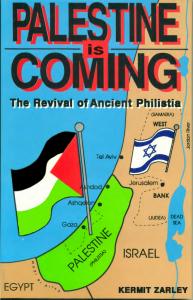 Therefore, I believe that after France leads several important nations next month in declaring their recognition of a Palestinian state, which they have never done, and when they do, over 150 nations of the total UN membership of 193 nations will then have “recognized a Palestinian state,” they should follow that up by recognizing the Gaza Strip as the Palestinian state with the recommendation that Israel swap land adjacent to the Gaza Strip in exchange for annexing all of the West Bank.
Therefore, I believe that after France leads several important nations next month in declaring their recognition of a Palestinian state, which they have never done, and when they do, over 150 nations of the total UN membership of 193 nations will then have “recognized a Palestinian state,” they should follow that up by recognizing the Gaza Strip as the Palestinian state with the recommendation that Israel swap land adjacent to the Gaza Strip in exchange for annexing all of the West Bank.
But the West Bank is far larger than any such adjacent land Israel will concede in exchange. Therefore, I also propose that Egypt become involved by agreeing to give land south of Gaza, in the northeastern portion of the Sinai Peninsula, to the Palestinians so that the exchange of territories would be equal in size. To do this, Israel must agree to some sort of arrangement with Egypt, whether it be monetarily or otherwise.
This result would be that a very expanded Gaza Strip, with all this surrounding territory, would approximate ancient Philistia, as the subtitle of my book says. (Ancient Philistia usually extended southward, 25 miles beyond the present Gaza Strip, to the Wadi el Arish and northward to Joppa—present Tel Aviv.)


